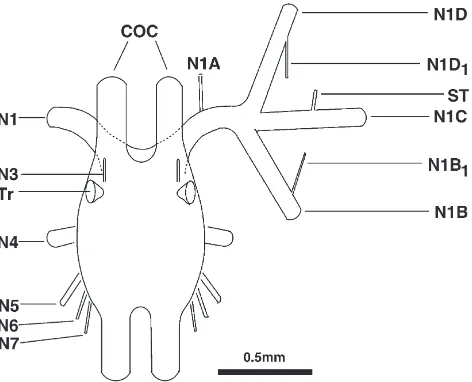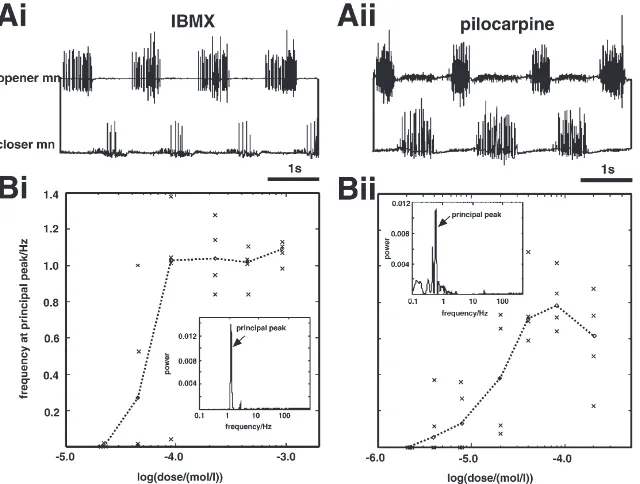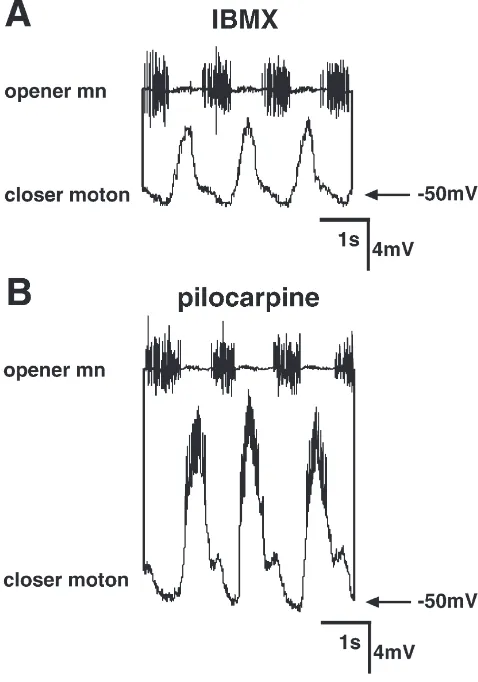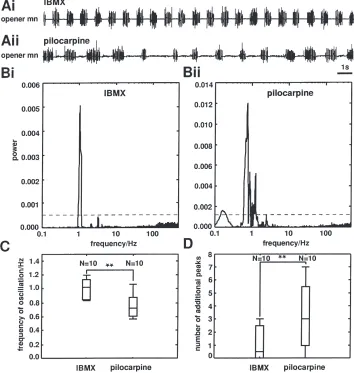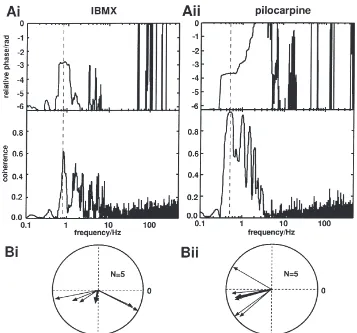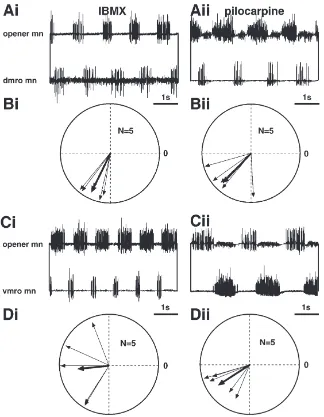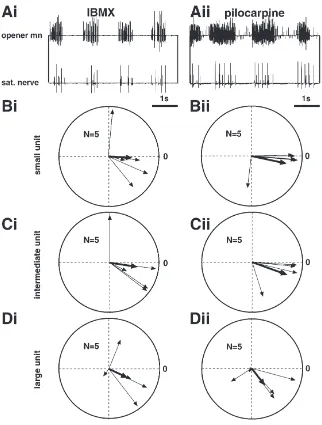www.elsevier.com/locate/jinsphys
Feeding-related motor patterns of the locust suboesophageal
ganglion induced by pilocarpine and IBMX
Georg F. Rast
a, b,*, Peter Bra¨unig
baInstitut fu¨r Zoologie, Technische Universita¨t Mu¨nchen, Lichtenbergstraße 4, 85747 Garching, Germany
bInstitut fu¨r Biologie II, Rheinisch-Westfa¨lische Technische Hochschule Aachen, Kopernikusstraße 16, 52056 Aachen, Germany
Received 24 January 2000; accepted 2 May 2000
Abstract
The mandibular motor pattern induced by the phosphodiesterase inhibitor 3-isobutyl-1-methylxanthine (IBMX) in isolated locust suboesophageal ganglia (SOG) was investigated and compared with the motor pattern induced by pilocarpine in an already estab-lished preparation of the SOG. Motor patterns occurring after bath application of IBMX or pilocarpine were recorded extracellularly from suitable nerves of isolated SOG. For a quantitative evaluation of long (15 min) sequences of rhythmic neural activity containing several hundred cycles, spectral analysis of spike trains was applied. Using a set of characteristic parameters extracted from spectra computed for each individual preparation, quantitative comparisons of the rhythms induced by IBMX and pilocarpine were made. Significant differences in regularity, frequency of oscillation, and intra-burst frequency were found whereas the phase relationships of different motor pools were similar. Differences in the effect of the drugs on the activity recorded extracellularly from mandibular closer motoneurones were investigated further using intracellular recordings. Our findings imply that the IBMX-induced motor pattern is a suitable in vitro model of mandibular central motor control like the pilocarpine induced pattern. The better regularity is an advantageous feature for further experiments on central pattern generation. Information on second messengers involved in central pattern generation provided by the pharmacological profile of IBMX forms a basis for pharmacological and histological investigations on the mandibular central pattern generating network. 2000 Elsevier Science Ltd. All rights reserved.
Keywords: Locusta migratoria; 3-isobutyl-1-methylxanthine (IBMX); Pilocarpine; Central pattern generation; Suboesophageal ganglion
1. Introduction
Locust feeding has been studied for a long time and from several perspectives. Patterning and sensory control of locust feeding was described quantitatively, especially with respect to numerous intrinsic and extrinsic influ-ences (Simpson 1990, 1996; Simpson et al., 1996), whereas central nervous mechanisms are still poorly understood. Most work has been performed with semi-intact preparations, e.g. the identification of mechano-and chemosensory interneurones (Simpson, 1992; Rog-ers and Simpson, 1999) or monitoring the activity of neurosecretory and visceromotor neurones (Bra¨unig, 1987; Baines et al., 1989). Later, recordings from these neurones were made in intact locusts (Schachtner and
* Corresponding author. Tel.: +49-241-804838; fax: +49-241-8888133.
E-mail address:[email protected] (G.F. Rast).
0022-1910/00/$ - see front matter2000 Elsevier Science Ltd. All rights reserved. PII: S 0 0 2 2 - 1 9 1 0 ( 0 0 ) 0 0 0 8 6 - X
Bra¨unig 1993, 1995), since their peculiar morphology renders them accessible. However, morphological con-straints impair the electrophysiological analysis of the central nervous networks integrating sensory information and controlling efferent neurones during feeding behav-iour.
1997). The pilocarpine-induced suboesophageal motor pattern involves both motoneurones to power muscles and to muscle receptor organs (Bra¨unig, 1990; Rast and Bra¨unig, 1997) representing important elements of puta-tive mandibular sensorimotor reflex loops (Seath, 1977a,b). Pilocarpine also affects the activity of a sero-tonergic neurohaemal system in the locust head (Bra¨unig, 1987).
Pharmacologically activated reduced preparations pro-vide good access to the central nervous system for invas-ive electrophysiological techniques; therefore such prep-arations proved to be valuable tools for the analysis of pattern generating neural circuits, although batch appli-cation of neuroactive substances may also lead to unspe-cific activation of neurones involved in other functional contexts than the motor pattern under investigation. If a set of different drugs is sufficient to influence rhythmog-enesis, a greater range of questions can be covered in experiments using these drugs, since the pattern generat-ing circuitry can be studied in different modes of oper-ation. For example, a large number of neuromodulators has been shown to modify centrally generated motor pat-terns pointing to modulator-dependent mechanisms of motor pattern reconfiguration (e.g. Simmers et al., 1995; Satterlie and Norekian, 1996; Hashemzadeh-Gargari and Friesen, 1089; Yeoman et al., 1996; Vehovszky et al., 1998; Ramirez and Pearson, 1991; Harris-Warrick and Cohen, 1985; Barthe and Grillner, 1995; Weimann et al., 1997; Sillar et al., 1998; Rossignol et al., 1998).
In this study a new tool for the induction of mandibu-lar motor patterns in the locust suboesophageal ganglion is introduced. The aim of the present study is to describe the locust mandibular motor pattern induced by IBMX and to compare it with the pattern known to be induced by pilocarpine (Rast and Bra¨unig, 1997). The motor pat-terns induced by IBMX and pilocarpine show similar phase relationships; however, they differ significantly in their cycle period, regularity, and the intra-burst activity of motoneurones. The latter finding is supported by a significantly different amplitude of the synaptic input to these motoneurones.
2. Materials and methods
2.1. Drugs
Drugs were purchased from Sigma-Aldrich Chemie GmbH, Steinheim, Germany. Stock solutions and final dilutions were prepared as follows using locust physio-logical saline (Clements and May, 1974): 3-isobutyl-1-methylxanthine (IBMX): 4.5 mM (stock solution), 450 µM (final dilution); pilocarpine: 10 mM (stock solution), 40 µM (final dilution).
2.2. Insects and preparation
Experiments were performed on adult African migratory locusts (Locusta migratoria migratorioides
R. & F.) taken from a crowded laboratory culture within the first week after final moult. Prior to dissection, locusts were immobilised by chilling to 4°C. Sub-sequently they were decapitated and the suboesophageal ganglion (SOG) was exposed after the removal of frons, clypeus, labrum, and the remainder of the foregut. Ana-tomical terms are taken from Snodgrass (1928); for an anatomical description of the mandibular motor system see Bra¨unig (1990). The peripheral nerves of the SOG were cut at suitable lengths. After severing the circumoe-sophageal connectives and the tentorium the SOG was excised from the head capsule leaving the main branches of the tracheal system intact and was pinned into a Petri dish coated with Sylgard (Dow Corning Corp., Midland, Michigan, USA); the stumps of the tracheae were opened at the surface of the saline.
2.3. Recordings, data acquisition, and evaluation
For intracellular recordings, the ganglionic sheath was softened with a few crystals of collagenase (type 1A, Sigma-Aldrich Chemie GmbH, Steinheim, Germany) for 90 s and cell somata were impaled with glass micropip-ettes (5% Lucifer Yellow in 1 M LiCl in the tip (Molecular Probes, Eugene, Oregon, USA) and 1 M LiCl in the shaft; resistance 20–60 MOhms). Cells were ident-ified by iontophoretic injection of Lucifer Yellow and/or correlation of extra- and intracellularly recorded spikes. For extracellular recordings, the endings of the periph-eral nerves of the SOG (see Fig. 1) were introduced into the tips of suction electrodes. Spikes were preamplified by Grass P15 amplifiers and stored with a DAT recorder (DTR 1404, Biologic, Grenoble, France). Play back data were converted into TTL pulses by analog window discriminators. The timings of the TTL pulses were stored with a personal computer using the CED 1401 interface and spike2 software (Cambridge Electronic Design, Cambridge, UK). Data analysis was performed using software written by the authors in C running under the LINUX operating system on a personal computer.
com-Fig. 1. Schematic dorsal view of the SOG with its peripheral nerves and primary arborisations of the mandibular nerve. Anterior is to the top. COC: circumoesophageal connectives; N: nerve; Tr: trachea; N1: mandibular nerve; N1B1: motor nerve of dorsal muscle receptor organ;
N1C: mandibular opener motor nerve; N1D: mandibular closer motor nerve; N1D1: motor nerve of ventral muscle receptor organ; ST:
satel-lite nerve. For detailed descriptions see Altman and Kien (1979) and Bra¨unig (1987, 1990).
mon frequencies, in coherence spectra; relative phase is extracted in phase spectra (for details see Rosenberg et al., 1989; Rigas, 1991; Dahlhaus et al., 1997; Miller and Sigvardt, 1998).
For example, the largest peak in the power spectrum of the spectral coherence shown in Fig. 5(Ai) (lower panel) indicates that a frequency of about 0.8 Hz is most common in both time series. This corresponds with the bursting frequency of the preparation (Fig. 2(Ai)). The intra-burst frequencies are distributed over too wide a range to form a single pronounced peak. The phase spec-trum shown in Fig. 5(Ai) (upper panel) indicates that the relative phase at this frequency (see dashed line) is about
2p, i.e. an alternation of bursts (Fig. 2(Ai)). Phase
relationships are always given with the mandibular opener activity as reference. Power and phase of the spectral coherence are displayed simultaneously as polar plots with the length of the vectors representing the coherence, and the angle of the vectors representing the relative phase (Fig. 5(Bi)).
Spectra were computed from 900 s of spiking activity sampled at a rate of 1 kHz. A windowed Cooley–Tukey fast Fourier transform algorithm was used to transform data with 262144 data points per window yielding spec-tra of the frequency range 0–500 Hz at a resolution of 262.144 data points per Hz.
Statistical tests on linear data were performed using theU-test, or, when more than two samples were tested, using the H-test (Statistical Package for the Social
Sciences (SPSS)); coherency data representing bivariate
samples with a linear variable (coherence) and a circular
variable (phase) were tested with a program written by the authors in C applying data transformation according to Mardia’s bivariate two sample test and a subsequent circular rank sum test as suggested in Batschelet (1981).
3. Results
3.1. Dose–response relationships
Both the phosphodiesterase inhibitor IBMX and the muscarinic agonist pilocarpine induce a mandibular motor pattern from isolated locust SOG (Fig. 2(Ai, Aii)). For both drugs the dose dependence of the cycle period was determined (Fig. 2(Bi, Bii)). Four individual prep-arations that had not been exposed to any drug before were tested for each dose. In each preparation the motor activity of the mandibular opener motoneurones was monitored for 15 min beginning approximately 5 min after application. From the resulting time series power spectra were computed and the location of the principal peak (the highest peak in the spectrum, see Fig. 2(Bi, Bii), insets), representing the bursting frequency, was plotted against the dose. In case no spike occurred in the observation period, the bursting frequency was set to zero. Both for IBMX and pilocarpine, the null hypothesis that samples drawn for the different doses do not differ can be rejected (H-test: p,0.05). Thus, the dosage has a significant effect on the frequency of oscillation despite the large inter-individual variance. The concentrations used as standards for the subsequent experiments (450 µM IBMX and 40 µM pilocarpine) were chosen in the saturation range (IBMX) or close to the peak fre-quency (pilocarpine).
3.2. IBMX induces less activity in the mandibular closer motoneurones
According to the results of backfills (P. Bra¨unig, unpublished observations), both mandibular opener and closer muscles are controlled by two pools of motoneu-rones. There is a minimum of 7 and a maximum of 12 motoneurones for each muscle. Uncertainties arise due to a variable number of serotonergic neurosecretory cells filled together with the motoneurones. The somata of these cells have similar locations to the motoneurones Bra¨unig (1987, 1988). The number of opener motoneu-rones recruited (5–7) is similar after application of pilo-carpine and IBMX, as revealed by inspection of spike shapes and spike sizes in the extracellular recordings (data not shown).
Fig. 2. IBMX and pilocarpine induce a mandibular motor pattern from isolated SOG. (A): Extracellular recordings from the mandibular opener and closer motor nerves after bath application of IBMX (Ai) and pilocarpine (Aii). (B): Dose response relationships for mandibular opener motor activity after bath application of IBMX (Bi) and pilocarpine (Bii); the stippled line connects median values of four individual preparations; insets: power spectra computed for 900 s sequences of mandibular opener activity showing the principal peaks (arrows). mn: motor nerve.
is significantly lower in preparations treated with IBMX (Fig. 2(Ai, Aii)). The spike frequency in the mandibular closer motor pools was averaged over a period of 500– 900 s yielding a measure of the overall activity of the neurones after application of either of the drugs (median values of 10 preparations per drug: IBMX: 0.77 Hz; pilo-carpine: 58.2 Hz; p,0.05; N=10); in five out of ten
IBMX-treated preparations less than one spike per cycle on average was recorded from the mandibular closer motor nerve.
Intracellular recordings from the somata of mandibu-lar closer motoneurones show that the reduced activity after application of IBMX is due to reduced synaptic input (Fig. 3(A, B)). The oscillation of the membrane potential differs significantly in its peak-to-peak ampli-tude after application of IBMX and pilocarpine (median values of 9 preparations per drug; 10 cycles evaluated each: IBMX: 4.6 mV; pilocarpine: 8.0 mV; p,0.05;
N=9). Nevertheless, at least subthreshold oscillatory
activity was present in all motoneurones recorded. This suggests that almost all motoneurones receive rhythmic synaptic input at varying strength.
3.3. IBMX induces a faster and more regular pattern than pilocarpine
Patterns have a significantly shorter cycle period when induced with IBMX (Fig. 4(Ai, Aii, C);p,0.05;N=10).
The bursting frequency was assessed for both drugs in ten individual preparations using the location of the
prin-cipal peak in the power spectrum of the mandibular opener motor activity (Fig. 4(Bi, Bii)). In addition, IBMX induces a more regular pattern which was quant-ified by counting the number of peaks larger than 10% of the principal peak size (dashed line) in the power spectra obtained from the activity of the mandibular opener motoneurones (Fig. 4(Ai, Aii, Bi, Bii, D); p,0.05;
N=10).
3.4. Similar phase relationships induced by IBMX and pilocarpine
3.4.1. Closer and opener motor activity
Mandibular closer and opener bursts alternate both in preparations superfused with IBMX and pilocarpine (Fig. 2(Ai, Aii)). Since in IBMX-treated preparations mandibular closer motor activity is greatly reduced (see above), for the assessment of closer/opener coupling rec-ordings were selected whose closer activity exceeded one spike per cycle on average. Typical example spectra are given in Fig. 5(Ai, Aii). The peak values of the power spectra and the corresponding relative phases are summarised in the polar plots shown in Fig. 5(Bi, Bii). Significant differences in the coherence of closer/opener motor activity after application of IBMX and pilocarpine could not be established (p.0.05;N=5). A relative phase
of less thanp/2 at powers close to 1 (Fig. 5(Bi))
Fig. 3. Mandibular closer motoneurones receive less synaptic input during the IBMX-induced motor pattern. Simultaneous recordings from the mandibular opener motor nerve (extracellular, upper trace) and a mandibular closer motoneurone (intracellular, lower trace) after application of IBMX (A) and pilocarpine (B). mn: motor nerve; moton: motoneurone.
timed at the termination of the opener burst and not in the middle of the opener inter-burst interval.
3.4.2. Contralateral coupling
We assume that contralateral coupling of the man-dibular opener motor activity has the same relative phase and strength in preparations treated with IBMX and pilo-carpine (Fig. 6(Bi, Bii); p.0.05; N=5). Contralateral
coupling of opener motoneurones is stronger and its phase is more constant among individual preparations than coupling of ipsilateral closer/opener motoneurones (Figs. 5 and 6). As ipsi/contralateral opener motoneu-rones are active synchronously whereas ipsilateral closer/opener motoneurones alternate, the spectral coher-ences of ipsi/contralateral opener motoneurones and ipsi-lateral closer/opener motoneurones differ significantly (p,0.05; N=5).
3.4.3. Motor output to muscle receptor organs
Both dorsal and ventral mandibular muscle receptor organs (dmro and vmro) couple to the mandibular motor pattern induced by IBMX or pilocarpine (Fig. 7). For the motor output to both muscle receptor organs no sig-nificant difference in the coherence after application of IBMX and pilocarpine could be established (p.0.05;
N=5) whereas there is a significant difference to the
coherence of ipsi/contralateral opener motoneurones (p,0.05;N=5) both after application of IBMX and
pilo-carpine. Although phase relationships vary considerably between individual preparations they are very stable within these preparations as can be seen from the length of the vectors in the polar plots (Fig. 7(B, D)). The spec-tral coherences of muscle receptor organ/opener motone-urones and closer/opener motonemotone-urones do not differ sig-nificantly except for the pair dmro/opener and closer/opener in the preparations treated with IBMX (p,0.05; N=5). Upon inspection of the polar plots in
Fig. 5(Ci) and Fig. 7(Ci) we conclude that this difference is not due to a different median relative phase but due to the high variability of the pair closer/opener motoneu-rones after application of IBMX (see above).
3.4.4. Coupling of neurosecretory cells
The spikes of the three paired serotonergic satellite neurones are distinguishable as three different units in extracellular recordings from the main branches of the satellite nervous system (Fig. 8(A); Bra¨unig, 1987). The satellite neurones synchronise with the mandibular motor pattern with varying phase relationship and coupling strength (Fig. 8(B–D)). However, the mean relative phase turns out to range quite consistently between 0 and2p/2 (thick arrows in Fig. 8(B–D)). This means that
satellite activity can be expected during and shortly after the opener bursts. A comparison of the spectral coher-ences of the different satellite units/opener motoneurones computed for preparations treated with IBMX and pilo-carpine did not yield significant differences (p.0.05;
N=5). In contrast, in comparing the coherence of satellite
units/opener activity with the coherence of ipsi/contralateral opener activity a significant difference was found for the small and the large unit but not for the intermediate unit (p,0.05; N=5).
4. Discussion
Fig. 4. The IBMX-induced motor pattern is significantly faster and more regular than the pilocarpine-induced pattern. (A): Recordings from the mandibular opener motor nerves of preparations superfused with IBMX (Ai) and pilocarpine (Aii). (B): Power spectra of 900 s of mandibular opener motor activity after application of IBMX (Bi) and pilocarpine (Bii); stippled line: 10% of the principal peak size. (C): Box-and-whisker plot comparing the bursting frequencies after application of IBMX and pilocarpine (p,0.01; N=10). (D): Box-and-whisker plot comparing the
number of peaks larger than 10% of the principal peak size after application of IBMX and pilocarpine (p,0.01;N=10).
However, differences in regularity, frequency, and spik-ing activity show that the two drugs act differently on the pattern generating network.
4.1. Dose–response curves
For IBMX, a saturation dose seems to exist above which the variance of the frequency of oscillation only depends on individual differences between the prep-arations and not on the dose (Fig. 2(Bi)). IBMX has been used in a wide range of doses with different preparations (Evans, 1984; Whim and Evans, 1991; Pannabecker and Orchard, 1987; Morton and Truman, 1985; Shibanaka et al., 1991). A possible explanation for the relatively high doses required in our preparation is the diffusion barrier of the intact ganglion sheath, as in work performed with lower doses ganglia were desheathed (Lundquist and Na¨ssel, 1997). To prevent degradation of cyclic guanylyl
monophosphate for immunohistochemical stainings, concentrations of the same order of magnitude as in the present study were used (Truman et al., 1996; Ball and Truman, 1998).
For pilocarpine a dose between 40µM and 80 µM is most likely to induce the highest frequencies of oscil-lation (Fig. 2(Bii)). At higher doses the frequency decreases which is mainly due to fusion of bursts into prolonged sequences of tonic activity. The standard dose was therefore chosen conservatively at 40 µM. The dose–response relationship determined for pilocarpine is in good concordance with results from other insect sys-tems (Ryckebusch and Laurent, 1993).
4.2. New features of the IBMX-induced pattern
Fig. 5. Coherency of mandibular closer and opener motor activity. (A): Representative coherence and phase spectra of 900 s of opener and closer motor activity in preparations treated with IBMX (Ai) and pilocarpine (Aii). Stippled line: frequency at principal peak. (B): Polar plots of the coherency of closer and opener motor activity for preparations treated with IBMX (Bi) and pilocarpine (Bii). The length of the vector indicates the coherence and the angle indicates the relative phase. Thin arrows: individual preparations; thick arrow: mean vector; circle: unit circle with radius=1; angles are to be read counter-clockwise from2ptop, 0 is to the right.
Fig. 7. Coherency of muscle receptor organ and mandibular opener motor activity. Dorsal muscle receptor organ (dmro): (A): Representative traces from preparations treated with IBMX (Ai) and pilocarpine (Aii). (B): Polar plots of the coherency of dmro and opener motor activity for preparations treated with IBMX (Bi) and pilocarpine (Bii). Ventral muscle receptor organ (vmro): (C): Representative traces from preparations treated with IBMX (Ci) and pilocarpine (Cii). (D): Polar plots of the coherency of vmro and opener motor activity for preparations treated with IBMX (Di) and pilocarpine (Dii). For further explanations see Fig. 5.
the standard concentrations of the drugs were chosen in a range where maximum activity can be expected (Fig. 2(B)). Thus, the differences found for the IBMX- and pilocarpine-treated preparations are due to specific properties of the motor patterns which are peculiar to the drug used. One reason for the reduced activity of the mandibular closer motoneurones in the IBMX-treated preparation is a reduced synaptic input to these neurones (Fig. 3) which leads to the interesting question whether the synaptic currents to motoneurones also differ quali-tatively in IBMX- and pilocarpine-treated preparations. The motor pattern induced by IBMX is more stable and faster compared to the motor pattern induced by pilocarpine (Fig. 4). A highly regular motor pattern can thus be centrally generated also in deafferented
prep-arations and does not necessarily require rhythmic sen-sory input when the appropriate drug for the induction of the motor pattern is used. Questions on central mech-anisms stabilising the motor pattern can therefore be addressed using the preparation treated with IBMX.
4.3. Similar phase relationships
Fig. 8. Coherency of satellite secretory and mandibular opener motor activity. (A): Representative traces from preparations treated with IBMX (Ai) and pilocarpine (Aii). (B)–(D): Polar plots of the coherency of satellite and opener activity for preparations treated with IBMX (Bi, Ci, Di) and pilocarpine (Bii, Cii, Dii). For further explanations see Fig. 5. sat: satellite.
(1997) that there may exist only a single central pattern generator driving both left and right mandibles in con-trast to thoracic motor rhythms which seem to be driven by separate coupled pattern generators for each joint (Ryckebusch and Laurent 1993, 1994; Bu¨schges et al., 1995). This is also in concordance with the observation that contralateral opener activity is strictly coupled to ipsilateral imposed movements in intact preparations (Seath, 1977b).
Coupling of closer and opener motoneurones is less strong and the relative phase varies to a greater extent between individual preparations. Closer activity might therefore rely more on proprioceptive feedback than on opener activity, which could be provided by sensory cues provided by the mandibular muscle receptor organs and other proprioceptors (Bra¨unig, 1990).
A comparison of the spectral coherences of opener/muscle receptor organ motoneurones shows that these proprioceptors receive motor input alternating with the mandibular opener motor bursts both in preparations treated with IBMX and pilocarpine. The importance of synchronized drive to power muscles and muscle recep-tor organs and the functional implications made in Rast and Bra¨unig (1997) become more prominent under the new aspect that this drive is equally obvious in prep-arations activated with different agents.
feeding behaviour (Schachtner and Bra¨unig, 1993), the cells may be coupled to the motor pattern in order to activate them but the exact timing within the short-term mandibular pattern might play a minor role and is thus not controlled strictly by the presynaptic network.
4.4. Second messengers in mandibular pattern generation
IBMX elevates the level of both cyclic adenylyl monophosphate (cAMP) and cyclic guanylyl monophos-phate (cGMP) in various tissues by blocking phosphodi-esterases which degrade cyclic nucleotide monophos-phates. For example, IBMX was used to elevate the level of cAMP in insect muscles (Evans, 1984; Whim and Evans, 1991; Baines et al., 1990) and in locust neuroen-docrine tissue (Pannabecker and Orchard 1986, 1987). On the other hand, IBMX mimicks cGMP-mediated hor-monal action like the induction of ecdysis behaviour by eclosion hormone in the hawkmoth and the silkworm (Morton and Truman, 1985; Shibanaka et al., 1991).
The question whether muscarinic receptors are directly or indirectly coupled to an elevation of cGMP levels is not solved in the locust; however, it was shown
in Manduca sexta larvae that such coupling is possible
(Qazi and Trimmer, 1999). Though, it was also shown in this system that in some identified neurones the effects of muscarinic agonists are not necessarily mediated by an elevation of cGMP (Qazi and Trimmer, 1999).
A goal for future experiments is to separate the central pattern generator into pharmacologically distinct parts and to identifiy individual neurones within this network. Cells with elevated levels of cAMP and cGMP might be detectable using immunocytochemical techniques. As mentioned in the introduction, muscarinic agonists are known to induce motor patterns in various invertebrate preparations, perhaps suggesting common mechanisms of pattern generation. Therefore it seems worthwile to investigate whether cyclic nucleotide-mediated pro-cesses represent a mechanism as common as muscarinic activation in other arthropod pattern generating net-works.
Acknowledgements
We thank Professor Stephen Simpson PhD, University of Oxford, Professor Dr. Ansgar Bu¨schges and Dr. Joachim Schmidt, University of Ko¨ln, for critically read-ing an earlier version of the manuscript. Dr. Michael Eichler, University of Heidelberg, gave useful hints con-cerning the implementation of the fast Fourier transform. Dr. Hanno Fischer, University of Ko¨ln, and Dr. Katrin Bo¨hning-Gaese, RWTH Aachen, helped to improve the statistics. This project was supported by DFG grant Br 882/3-2.
References
Altman, J.S., Kien, J., 1979. Suboesophageal neurons involved in head movements and feeding in locusts. Proceedings of the Royal Society of London, Series B: Biological Sciences 205, 209–227. Baines, R.A., Tyrer, N.M., Downer, R.G.H., 1990. Serotonergic
inner-vation of the locust mandibular closer muscle modulates contrac-tions through the elevation of cyclic adenosine monophosphate. The Journal of Comparative Neurology 294, 623–632.
Baines, R.A., Tyrer, N.M., Mason, J.C., 1989. The innervation of locust salivary glands I. Innervation and analysis of transmitters. Journal of Comparative Physiology A 165, 395–405.
Ball, E.E., Truman, J.W., 1998. Developing grasshopper neurons show variable levels of guanylyl cyclase activity on arrival at their tar-gets. The Journal of Comparative Neurology 394, 1–13. Barthe, Y., Grillner, S., 1995. Neurotensin-induced modulation of
spi-nal neurons and fictive locomotion in the lamprey. Jourspi-nal of Neur-ophysiology 73 (3), 1308–1312.
Batschelet, E., 1981. Circular Statistics in Biology. Academic Press, London, New York, Toronto, Sydney, San Francisco.
Braun, G., Mulloney, B., 1995. Coordination in the crayfish swimmeret system: differential excitation causes changes in intersegmental phase. Journal of Neurophysiology 73 (2), 880–885.
Bra¨unig, P., 1987. The satellite nervous system — an extensive neuro-haemal network in the locust head. Journal of Comparative Physi-ology A 160, 69–77.
Bra¨unig, P., 1988. Neurosecretory cells of the locust suboesophageal ganglion. Symposia Biologica Hungarica 36, 161–171.
Bra¨unig, P., 1990. The mandibular ganglion — a new peripheral gang-lion of the locust. The Journal of Experimental Biology 148, 313–324.
Bu¨schges, A., Schmitz, J., Ba¨ssler, U., 1995. Rhythmic patterns in the thoracic nerve cord of the stick insect induced by pilocarpine. The Journal of Experimental Biology 198, 435–456.
Chrachri, A., Clarac, F., 1990. Fictive locomotion in the fourth thoracic ganglion of the crayfish,Procambarus clarkii. The Journal of Neu-roscience 10, 707–719.
Clements, A.N., May, T.E., 1974. Studies on locust neuromuscular physiology in relation to glutamic acid. The Journal of Experi-mental Biology 60, 673–705.
Dahlhaus, R., Eichler, M., Sandku¨hler, J., 1997. Identification of syn-aptic connections in neural ensembles by graphical models. Journal of Neuroscience Methods 80, 93–107.
Elson, R.C., Selverston, A.I., 1992. Mechanisms of gastric rhythm gen-eration in the isolated stomatogastric ganglion of spiny lobsters: bursting pacemaker potentials, synaptic interactions, and muscar-inic modulation. Journal of Neurophysiology 68 (3), 890–907. Evans, P.D., 1984. Studies on the mode of action of octopamine,
5-hydroxytryptamine and proctolin on a myogenic rhythm in the locust. The Journal of Experimental Biology 110, 231–251. Harris-Warrick, R.M., Cohen, A.H., 1985. Serotonin modulates the
central pattern generator for locomotion in the isolated lamprey spinal cord. The Journal of Experimental Biology 116, 27–46. Hashemzadeh-Gargari, H., Friesen, W.O., 1089. Modulation of
swim-ming activity in the medicinal leech by serotonin and octopamine. Comparative Biochemistry and Physiology C 94 (1), 295–302. Heinrich, R., Hedwig, B., Elsner, N., 1997. Cholinergic activation of
stridulatory behaviour in the grasshopperOmocestus viridulus. The Journal of Experimental Biology 200 (9), 1327–1337.
Johnston, R.M., Levine, R.B., 1996. Crawling motor patterns induced by pilocarpine in isolated larval nerve cords of Manduca sexta. Journal of Neurophysiology 76 (5), 3178–3195.
Miller, W.E., Sigvardt, K.A., 1998. Spectral analysis of oscillatory neural circuits. Journal of Neuroscience Methods 80, 113–128. Morton, D.B., Truman, J.W., 1985. Steroid regulation of the
peptide-mediated increase in cyclic GMP in the nervous system of the hawkmoth,Manduca sexta. Journal of Comparative Physiology A 157 (4), 423–432.
Pannabecker, T., Orchard, I., 1986. Octopamine and cyclic AMP mediate release of adipokinetic hormone I and II from isolated locust neuroendocrine tissue. Molecular and Cellular Endocrin-ology 48 (2–3), 153–159.
Pannabecker, T., Orchard, I., 1987. Regulation of adipokinetic hor-mone release from locust neuroendocrine tissue: participation of calcium and cyclic AMP. Brain Research 423 (1–2), 13–22. Qazi, S., Trimmer, B.A., 1999. The role of inositoll,4,5-trisphosphate
5-phosphatase in inositol signaling in the CNS of larvalManduca sexta. Insect Biochemistry and Molecular Biology 29, 161–175. Ramirez, J.-M., Pearson, K.G., 1991. Octopaminergic modulation of
interneurons in the flight system of the locust. Journal of Neurophy-siology 66 (5), 1522–1537.
Rast, G.F., Bra¨unig, P., 1997. Pilocarpine-induced motor rhythms in the isolated locust suboesophageal ganglion. The Journal of Experi-mental Biology 200, 2197–2207.
Rigas, A.G., 1991. Spectral analysis of stationary point processes using the fast Fourier transform algorithm. Journal of Time Series Analy-sis 13 (5), 441–450.
Rogers, S.M., Simpson, S.J., 1999. Chemo-discriminatory neurones in the sub-oesophageal ganglion ofLocusta migratoria. Entomologia Experimentalis et Applicata 91, 19–28.
Rohrbacher, J., 1994. Mandibular premotor interneurons of larval Man-duca sexta. Journal of Comparative Physiology A 157, 619–628. Rosenberg, J.R., Amjad, A.M., Breeze, P., Brillinger, D.R., Halliday,
D.M., 1989. The Fourier approach to the identification of functional coupling between neuronal spike trains. Progress in Biophysics and Molecular Biology 53 (1), 1–31.
Rossignol, S., Chau, C., Brustein, E., Giroux, N., Bouyer, L., Barbeau, H., Reader, T.A., 1998. Pharmacological activation and modulation of the central pattern generator for locomotion in the cat. Annals of the New York Academy of Science 860, 346–359.
Rowell, C.H.F., Simpson, S.J, 1992. A peripheral input of thoracic origin inhibits chewing movements in the larvae ofManduca sexta. Journal of Insect Physiology 38 (7), 475–483.
Ryckebusch, S., Laurent, G., 1993. Rhythmic patterns evoked in locust leg motor neurons by the muscarinic agonist pilocarpine. Journal of Neurophysiology 69 (5), 1583–1595.
Ryckebusch, S., Laurent, G., 1994. Interactions between segmental leg central pattern generators during fictive rhythms in the locust. Jour-nal of Neurophysiology 72 (6), 2771–2785.
Satterlie, R.A., Norekian, T.P., 1996. Modulation of swimming speed in the pteropod mollusc,Clione limacina: role of a compartmental serotonergic system. Invertebrate Neuroscience 2 (3), 157–165. Schachtner, J., Bra¨unig, P., 1993. The activity pattern of identified
neurosecretory cells during feeding behaviour in the locust. The Journal of Experimental Biology 185, 287–303.
Schachtner, J., Bra¨unig, P., 1995. Activity pattern of suboesophageal ganglion cells innervating the salivary glands of the locustLocusta migratoria. Journal of Comparative Physiology A 176, 491–501. Seath, I., 1977a. The effects of increasing mandibular load on electrical
activity in the mandibular closer muscles during feeding in the desert locust,Schistocerca gregaria. Physiological Entomology 2, 237–240.
Seath, I., 1977b. Sensory feedback in the control of mouthpart move-ments in the desert locust, Schistocerca gregaria. Physiological Entomology 2, 147–156.
Shibanaka, Y., Hayashi, H., Okada, N., Fujita, N., 1991. The crucial role of cyclic GMP in the eclosion hormone mediated signal trans-duction in the silkworm metamorphoses. Biochemical and Biophys-icul Research Communications 180 (2), 881–886.
Sillar, K.T., Reith, C.A., McDermid, J.R., 1998. Development and aminergic neuromodulation of a spinal locomotor network con-trolling swimming in Xenopus larvae. Annals of the New York Academy of Sciences 860, 318–332.
Simmers, J., Meyrand, P., Moulins, M., 1995. Modulation and dynamic specification of motor rhythm-generating circuits in crustacea. Jour-nal of Physiology Paris 89 (4–6), 195–208.
Simpson, S.J., 1990. The pattern of feeding. In: Chapman, R., Joern, A. (Eds.), Biology of Grasshoppers. John Wiley and Sons, New York, pp. 73–103, Chapter 3.
Simpson, S.J., 1992. Mechanoreceptive neurons in the subesophageal ganglion of the locust. Physiological Entomology 17 (4), 351–369. Simpson, S.J., 1996. Regulation of a meal: Chewing insects. In: Chap-man, R.F., De Boer, G. (Eds.), Regulatory Mechanisms in Insect Feeding. Chapman and Hall, New York, pp. 137–156, Chapter 5. Simpson, S.J., Raubenheimer, D., Chambers, P.G., 1996. The mech-anisms of nutritional homeostasis. In: Chapman, R.F., De Boer, G. (Eds.), Regulatory Mechanisms in Insect Feeding. Chapman and Hall, New York, pp. 137–156, Chapter 9.
Snodgrass, R.E., 1928. Morphology and evolution of the insect head and its appendages. Smithsonian Miscellaneous Collections 81, 1–158.
Truman, J.W., De Vente, J., Ball, E.E., 1996. Nitric oxide-sensitive guanylate cyclase activity is associated with the maturational phase of neuronal development in insects. Development 122, 3949–3957. Vehovszky, A., Elliott, C.J.H., Voronezhskaya, E.E., Hiripi, L., Elekes, K., 1998. Octopamine: a new feeding modulator inLymnaea. Philo-sophical Transactions of the Royal Society of London, Series B: Biological Sciences 353, 1621–1629.
Weimann, J.M., Skiebe, P., Heinzel, H.-G., Soto, C., Kopell, N., Jorge-Rivera, J.C., Marder, E., 1997. Modulation of oscillator interactions in the crab stomatogastric ganglion by crustacean cardioactive pep-tide. The Journal of Neuroscience 17 (5), 1748–1760.
Whim, M.D., Evans, P.D., 1991. The role of cyclic AMP in the octopa-minergic modulation of flight muscle in the locust. The Journal of Experimental Biology 161, 423–438.
